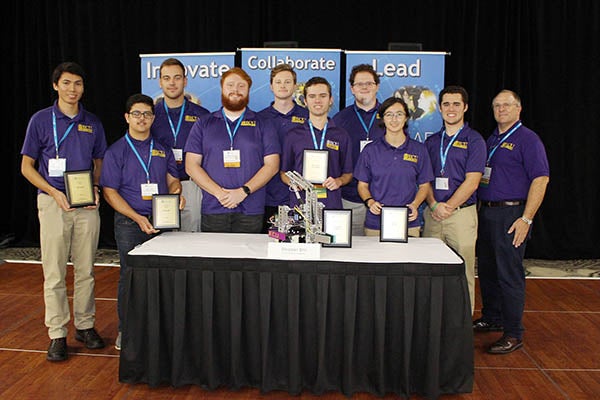ECU robotics team wins awards at national competition
High finishes in national robotics competitions are becoming a habit for the Association of Technology, Management and Applied Engineering team from East Carolina University.
The team returned from the ATMAE national conference in Orlando, Florida, with five awards, including first place in the warehouse competition, first place in robot tag and second place overall.

Faculty advisor Bill McClung, right, stands with members of East Carolina University’s chapter of the Association of Technology, Management and Applied Engineering organization with their awards from the ATMAE national robotics competition in Florida. (Contributed photo)
“We were hoping to take first place overall, but it didn’t quite work out because of a technicality we missed, but our robot outperformed every other robot on the field, and that’s what we were really going for,” said club president Mason Caroon, a junior engineering major.
Before the pandemic put a hold on the competition in 2019, the team took first place overall in the event.
“In terms of the actual robot competition, we were first,” Caroon said. “We were first last year, we were first this year and we’re going to be first next year. I don’t intend to lose until I graduate.”
Student teams build robots that are tasked with picking up objects of various weights and sizes from storage racks and placing them in assigned locations in a simulated warehouse setting, all without dropping the objects or running into obstacles that are placed in the robot’s path.
ECU’s team started work in the spring and continued throughout the summer and fall before the competition Nov. 3-5.
Work on this particular robot focused on improvements to the 2019 winning robot called Pegleg. The new version, called Stepper Bro, featured an upgraded gripper so the robot could hold objects better, a belt system that allowed the gripper to go up and down smoothly, and a taller vertical device on which the gripper moves that folded to meet height requirements of the competition.
“We decided we wanted to make the vertical taller, but it can’t be more than 18 inches initially, so we split the middle and put it on a hinge,” Caroon said. “We were concerned the gripper wouldn’t go up and down over the hinge, but that turned out not to be a problem at all. That was fortunate.”
He said the biggest challenge may have come in programming the robot’s drive motors.
“Those drive motors (cost) a pretty penny and are very difficult to program,” Caroon said. “We decided to control it with an Arduino, and there was no documentation on it. Our programmer (Van Ravesteyn) had to reverse engineer it to get the information to use them. About 150 hours went into it, but we were able to use it and it worked very well for us.”

Mason Caroon, president of ECU’s ATMAE chapter, operates the robot through a course in the Science and Technology Building. (Photo by Ken Buday)
Team member Brandon Scott said the team worked with ECU graduate Sean Wear, who helped create the winning robot in 2019.
“He knew everything about the last robot, and he was able to work and get everything that he saw as a problem corrected for this year’s robot,” Scott said.
Along with the team awards, two members brought home individual awards in the Technology IQ Challenge, a Jeopardy-style game with questions that focus on manufacturing, communication, construction, safety, electronics, energy, equality, and management. Reuben Unicruz, a mechanical design technology major in the industrial technology transfer program, took second place, while Isaac Carlos, an industrial engineering technology major, finished third.
ECU’s ATMAE organization includes students from a variety of programs in the College of Engineering and Technology. Other team members who attended the conference include Evan Blanton, Kevin Davis, Robert Malpass and Erica Walker. Faculty advisors are Bill McClung and Amy Frank.
Beyond the robot competition, the three-day conference featured presentations, breakout sessions, speakers, industry representatives and networking opportunities.
“Going to these types of events, there are tons of people that you can talk to and meet to get some sort of idea about what they’re looking for (in employees),” Scott said. “There was a small panel group about what to do and what questions they’ll ask during an interview, how to answer them and what questions you need to ask. The conference is a good networking experience. There are a lot of opportunities. It’s not just building the robot and getting hands-on experience. It’s about getting to know people in the industry.”
Caroon said working as a member of ECU’s ATMAE robotics team in 2019 helped him secure an internship with Cisco.
“Talking about this experience with companies, they eat it up,” he said. “Your resume and your GPA go out the door. They want to hear about this autonomous forklift you’ve made. It shows employers you’re a person with interests and that you can produce good work.”
Plus, working as a team to build a robot can be just plain fun.
“I enjoyed being able to work with others and collaborate,” Scott said.
“This is my first priority. Don’t tell any of my professors,” Caroon said. “I have gained so much from this. It’s just so much fun. Even when it fails it’s fun. Just going from an idea to reality is such a fun time.”
Students interested in becoming a member of ECU’s ATMAE team can go online to the college’s student organizations webpage.

Erica Walker and Van Ravesteyn work on the ATMAE robot in the Science and Technology Building. (Photo by Ken Buday)
Related:
Kicking Bot: Team of ECU students wins robot competition at national tech conference